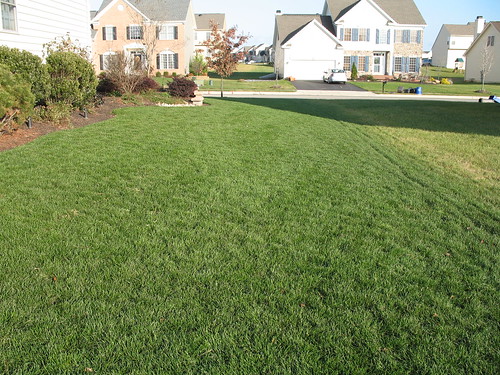The lawn's starting to lose color for winter, which is fairly normal. It's still the greenest in the area, but I'm going to try spraying a little iron on it to put that into root storage for spring. That should accelerate spring green-up, as well as change the color a bit.
I sprayed yesterday with kelp, humates, and soil conditioner as well and that seemed to change the color to a bit darker this morning.
Wednesday, December 2, 2009
December Photo
Tuesday, December 1, 2009
Kentucky Bluegrass Winter Seeding
I've done the first winter seeding (of three) of the lawn, including lightly scratching the soil and distributing seed by hand at about 1 pound per thousand.
Winter, or frost, seeding is done after soil temperatures drop under fifty (ours are actually about 48 right now, but descending fast). The seed won't germinate until spring, although normal freeze-thaw cycles will carry it into the soil fairly effectively. Unless the spring is quite dry, it doesn't need to be watered, but will require some coddling the following summer until it matures--usually the following fall.
Frost seeding isn't as effective as a fall seeding at the appropriate time (around Labor Day or a bit earlier here). However, it's more successful than a spring seeding would be, since I don't have to worry about hitting the correct window of soil temperatures. The seed will sprout the first instant it can.
I tend to divide the seedings into three--December, which is put down on scratched soil, as well as February and again in March, which are scattered as the soil is still frozen at that time. However, one seeding would be quite sufficient.
The mix I chose is a bit different this year:
Midnight II--a Compact-Midnight type. This was in my original lawn, and makes up 33% of the mix this time. This is one of the more available elite bluegrasses, and has been in continuous and heavy production for ages.
Brilliant--a Compact-America type, 20% of the mix. This is to replace the Moonlight in the original lawn which is now extremely difficult to get in sod quality from my preferred suppliers. I have no experience with this grass, but the color should be comparable.
Prosperity--A Compact type, 20% of the mix. This is to replace the Bedazzled in the original lawn, which is similarly difficult to get. I used this on the back line and it's slightly darker than Bedazzled, although not enough to notice.
Blueberry--A Compact type, 13% of th mix. I'm testing this as according to reports it's quite dark and a beautiful grass.
Moonbeam--A Compact type, 13% of the mix. This is another test grass, and again, quite dark.
To keep the darker colored grasses from being obvious, I also seeded a band around the repaired areas. The mix should blend fairly well, but if not I'll overseed with Blueberry and Moonbeam next fall across the entire lawn.